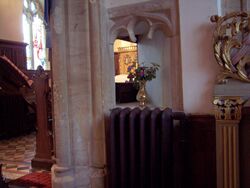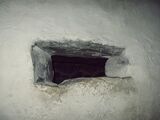Engineering:Hagioscope
A hagioscope (from grc άγιος (ágios) 'holy', and σκοπεῖν (skopeîn) 'to see') or squint is an architectural term denoting a small splayed opening or tunnel at seated eye-level, through an internal masonry dividing wall of a church in an oblique direction (south-east or north-east), giving worshippers a view of the altar and therefore of the elevation of the host.[1] Where worshippers were separated from the high altar not by a solid wall of masonry but by a transparent parclose screen, a hagioscope was not required as a good view of the high altar was available to all within the sectioned-off area concerned. Where a squint was made in an external wall so that lepers and other non-desirables could see the service without coming into contact with the rest of the populace, they are termed leper windows or lychnoscopes.
Function
Where the congregation of a church is united in the nave there is no use for a hagioscope. However, when parts of the congregation separated themselves for purposes of social distinction, by use of walls or other screens from the chancel, or nave, and from the main congregation, such a need arose. In medieval architecture hagioscopes were often a low window in the chancel wall and were frequently protected by either a wooden shutter or iron bars. Hagioscopes are found on one or both sides of the chancel arch; in some cases a series of openings has been cut in the walls in an oblique line to enable a person standing in the porch (as in Bridgwater church, Somerset) to see the altar; in this case and in other instances such openings were sometimes provided for an attendant, who had to ring the Sanctus bell when the Host was elevated.[1]
Though rarely encountered in continental Europe, they are occasionally found to serve such purposes as allowing a monk in one of the vestries to follow the service and to communicate with the bell-ringers.[1] Sometimes squints were placed to enable nuns to observe the services without having to give up their isolation. The unusual design of the church of St Helen's in Bishopsgate, one of the largest surviving ancient churches of London, arose from its once having been two separate places of worship: a 13th-century parish church and the chapel of a Benedictine convent. On the convent side of St Helen's Church, a "squint" allowed the nuns to observe the parish masses; church records show that the squint in this case was not enough to restrain the nuns, who were eventually admonished to "abstain from kissing secular persons", a practice to which it seems they had become "too prone".[2]
Surviving examples
Finland
There is only one hagioscope in Finland, at Olavinlinna (St. Olaf's Castle), in the town of Savonlinna. Here, the squint has enabled some congregants to continue gathering at the dark, damp stone church tower through the dead of winter, despite forbidding temperatures and weather conditions.[3]
France
In France, the hagioscope of Notre-Dame in Dives-sur-Mer, Normandy, has the inscription trou aux lépreux (leper window). Other hagioscopes are known at St. Laurent in Deauville, Normandy and at the old church of St. Maurice in Freyming-Merlebach, Lorraine.
Germany
In Germany, a number of hagioscopes still exist or were rediscovered in the 19th and 20th century. They are found mainly in Lower Saxony which had a small population in the Middle Ages and only a few bigger cities. In cities lepers lived together in housing estates which often had their own chapels. In Georgsmarienhütte the hagioscope of church St. Johann belonged to the former Benedictine convent Kloster Oesede, founded in the 12th century and reconstructed in the early 1980s. Nearby in Bad Iburg a hagioscope was rediscovered at St. Clemens, church of former Benedictine monastery in the castle and monastery complex Schloss Iburg. Other hagioscopes in Lower Saxony are found in Bokelesch, Westoverledingen, Dornum, Midlum, Kirchwahlingen (Gemeinde Böhme) and Hankensbüttel.
In Northrhine-Westphalia, St. Antonius-Kapelle in Gescher-Tungerloh-Capellen has a hagioscope. St. Antonius is used as Autobahn chapel at Bundesautobahn 31. Another hagioscope is found in St. Ulricus in Börninghausen. In Rhineland-Palatinate the church of St. Eligius-Hospital in Neuerburg has a hagioscope. In Baden-Württemberg there is a hagioscope in St. Peter und Paul, the Old Cemetery Church of Nusplingen.
Ireland
- A leper's squint (now blocked up) is visible at St Mary's Cathedral, Limerick.
- Athenry Priory also once had a leper's squint
- Furness Church, 13th century Norman church near Naas
- St Mary's Church, Inis Cealtra has a stone opening believed to be a leper's squint[4]
Netherlands
St. Vitus in Wetsens, and Jistrum, both in Friesland, have hagioscopes, as does the oldest church in the Netherlands, which stands in Oosterbeek.[5]:141–142
Sweden
In Sweden, Bro Church near Visby on Gotland has a cross-shaped hagioscope. Another church on Gotland with a hagioscope is Atlingbo Church. Other hagioscopes are at the church of Vreta Abbey near Linköping, Granhult Kyrka in Uppvidinge and Husaby Kyrka in Götene. The wooden church in Granhult (Småland) has a hagioscope which can be closed.
United Kingdom
Churches in England with hagioscopes include:
- Church of St Mary the Virgin, Gamlingay, Cambridgeshire[6]
- St Martin and St Meriadoc's Church, Camborne, Cornwall[citation needed]
- St Wynwallow's Church, Landewednack, Cornwall[7]
- St Martin's Church, Liskeard, Cornwall
- St Anietus's Church, St Neot, Cornwall[8]
- St Corentin's Church, Cury, Cornwall[9]
- Church of St Mylor, Mylor, Cornwall[citation needed]
- St Martin's Church, St Martin-by-Looe, Cornwall[10]
- St Cyricius and St Julietta's Church, St Veep, Cornwall[11]
- Church of St Sampson, South Hill, Cornwall[12]
- Stoke Climsland Church, Cornwall[13]
- St Petroc's Church, Trevalga, Cornwall[14]
- St James' in Great Ormside, Cumbria[15]
- St Bees Priory, St Bees, Cumbria (now infilled)Lua error: not enough memory.
- St Mary's Bridge Chapel, DerbyLua error: not enough memory.
- St Mary's, Lytchett Matravers, Dorset[16] (a particularly large example)
- St Martin's Church in Wareham, DorsetLua error: Internal error: The interpreter exited with status 1.
- St Mary and St Cuthbert, Chester-le-Street, Durham[17]
- St Mary's Church, Easington, County Durham[18]
- St Thomas à Becket Church, Lewes, East Sussex[19]
- St Nicholas' Church, Berden, EssexLua error: Internal error: The interpreter exited with status 1.
- St. Laurence and All Saints Church, Eastwood, Essex[20][21]
- St Andrew and St Bartholomew's Church, Ashleworth, Gloucestershire[22]
- St Nicholas's Church, Westgate Street, Gloucester, GloucestershireLua error: Internal error: The interpreter exited with status 1.
- Church of the Holy Rood, Holybourne, Hampshire[23]
- St Mary's Church, Brook, KentLua error: Internal error: The interpreter exited with status 1.
- St Cuthbert's Church, Aldingham, Lancashire[24]
- St Cuthbert's Church, Halsall, Lancashire has six purposeful squints or hagioscopes including a double one in the chancel arch and a remarkable triple hagioscope which was built for exclusive viewing of the Easter Sepulchre during Holy Week.Lua error: Internal error: The interpreter exited with status 1.
- St Wilfrid's church, Ribchester, Lancashire has a squint on the north side permitting the high altar to be viewed from outside the church.* St Nicholas's Church, Walcot, Lincolnshire
- St James The Less, Sulgrave, Northamptonshire[25]
- St Mary's Church, Grendon, Northamptonshire (see picture in Gallery)
- St Cuthbert's Church, Beltingham, Northumberland[26]
- St Aidan's Church, Bamburgh, NorthumberlandLua error: Internal error: The interpreter exited with status 1.
- Selby Abbey, Selby, North Yorkshire.
- Church of St Andrew, Grinton, North YorkshireLua error: Internal error: The interpreter exited with status 1.
- St Oswald's Church, Sowerby, North Yorkshire[27]
- Holy Trinity Church, Goodramgate, York, North Yorkshire
- St Mary's Church, Whitby, North YorkshireLua error: Internal error: The interpreter exited with status 1.
- St Peter's in Upton, Nottinghamshire[28]
- St Nicholas's Church, Old Marston, Oxfordshire[29]
- Church of the Blessed Virgin Mary, Compton Pauncefoot, SomersetLua error: Internal error: The interpreter exited with status 1.
- St Mary's Church, West Chiltington, West SussexLua error: Internal error: The interpreter exited with status 1.
- St Mary the Virgin & St Chad, Brewood, StaffordshireLua error: Internal error: The interpreter exited with status 1.
- Orford Castle's chapel, SuffolkLua error: Internal error: The interpreter exited with status 1.
- The Church of St. James, Shere, SurreyLua error: Internal error: The interpreter exited with status 1.
- St Nicholas' Church, Kenilworth, Warwickshire[30]
- St Mary's Church, West Chiltington, West SussexLua error: Internal error: The interpreter exited with status 1.
- Holy Trinity Church, Bradford-on-Avon, WiltshireLua error: Internal error: The interpreter exited with status 1.
- St Egwin's, Norton and Lenchwick, north of Evesham, Worcestershire (now infilled)Lua error: Internal error: The interpreter exited with status 1.
- St Mary's Church in Winchcombe, Gloucestershire
At St Bees Priory a purpose-built squint was included in the wall of the 14th-century chapel to give a view of the high altar. The window was low enough to allow a person to kneel whilst looking through the aperture. The hagioscope at St Mary the Virgin, Lytchett Matravers, is unusually large; although unknown in origin it provides a view to the communion table from the 16th-century north aisle. It is large enough that it is often used as a corridor for access to the chancel.Lua error: Internal error: The interpreter exited with status 1.
Gallery
See also
References
- ↑ 1.0 1.1 1.2
 One or more of the preceding sentences incorporates text from a publication now in the public domain: Lua error: Internal error: The interpreter exited with status 1.
One or more of the preceding sentences incorporates text from a publication now in the public domain: Lua error: Internal error: The interpreter exited with status 1.
- ↑ Kettler, Sarah; Trimble, Carole (2001). The Amateur Historian's Guide to Medieval and Tudor London, 1066–1600. Capital Books. p. 113. ISBN 1892123320. https://archive.org/details/amateurhistorian00kett_1/page/113.
- ↑ Hicks, M., Landscapes of Finland (Helsinki: Otava, 2003), p. 117.
- ↑ "St Mary's Church, Inishcaltra". http://www.megalithicireland.com/St%20Mary's%20Church,%20Inishcealtra.html.
- ↑ Kuyper, W., The Triumphant Entry of Renaissance Architecture into the Netherlands (Alphen aan den Rijn: Canaletto, 1994), pp. 141–142.
- ↑ Gamlingay – British History Online
- ↑ Landewednack, St Wynwallow's Church, Lizard; britainexpress.com
- ↑ St Neot; the Church
- ↑ Church of Saint Corentin, Cury; British Listed Buildings
- ↑ Guide to South Cornwall; 14th ed. London: Ward Lock, [c. 1955]; p. 128
- ↑ St Ciricus and St Julitta's Church, St Veep; British Listed Buildings
- ↑ Church of St Sampson, South Hill; British Listed Buildings
- ↑ Stoke Climsland Church; British Listed Buildings
- ↑ St Petroc's Church, Trevalga; British Listed Buildings
- ↑ "Great Ormside – St James' Church". http://www.visitcumbria.com/pen/chp16.htm.
- ↑ [St Mary's church website|http://www.stmarys-lytchett.org.uk/page6.htmlLua error: Internal error: The interpreter exited with status 1. StMary's Website]
- ↑ "St Mary and St Cuthbert, Ankers House". http://www.maryandcuthbert.org.uk/parish-church-/ankers-house/.
- ↑ "LEPER'S SQUINT?". http://www.turning-the-tide.org.uk/news/read.asp?ID=70.
- ↑ "St Thomas à Becket Church – The Anglican parish church of the Cliffe, Lewes, East Sussex". https://st-thomas-lewes.org.uk/.
- ↑ "History Part Two". St Laurence & All Saints, Eastwood, Essex. 2010. http://www.st-laurence.org.uk/history2.html.
- ↑ "The hagioscope". St Laurence & All Saints, Eastwood Church. Essex churches. http://www.essexchurches.info/images/018/0186i013.jpg.
- ↑ St Andrew and St Bartholomew Church
- ↑ Church of The Holy Rood The Holybourne Village Magazine Spring Issue 2009
- ↑ "What is it? A leper's squint". https://scribalterror.blogs.com/scribal_terror/2008/03/what-is-it.html.
- ↑ "The Church " Sulgrave Village Website". http://www.sulgrave.org/Sulgrave%20Church/Church01.html.
- ↑ Ridley, Nancy (1966). Portrait of Northumberland. London: Robert Hale. pp. 66–67.
- ↑ "History | St Oswald's Church, Sowerby, Thirsk, North Yorkshire". http://www.stoswaldsowerby.org.uk/history.shtml.
- ↑ MR. HARRY GILL Upton (part 1)
- ↑ "Church of St Nicholas, Elsfield Road, Old Marston". http://www.headington.org.uk/history/marston_history/listed/133_church.htm.
- ↑ "St Nicholas & St Barnabas Churches Kenilworth". http://www.stnicholaskenilworth.org.uk/history.htm.
Lua error: Internal error: The interpreter exited with status 1.
Lua error: Internal error: The interpreter exited with status 1.







